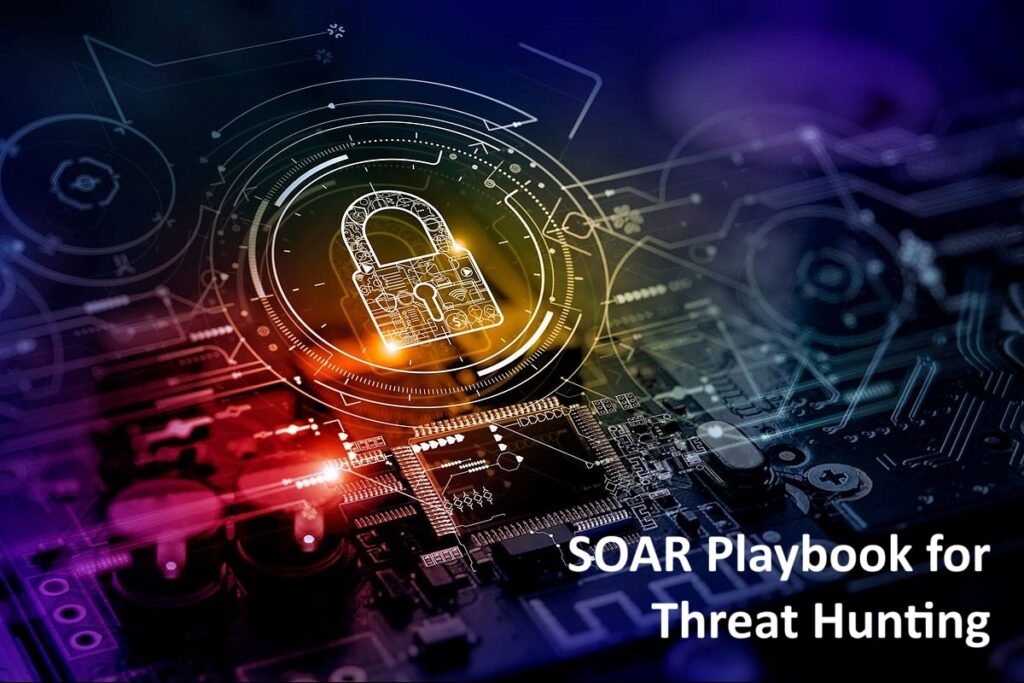
Status: Final Blueprint
Author: Shahab Al Yamin Chawdhury
Organization: Principal Architect & Consultant Group
Research Date: March 9, 2025
Location: Dhaka, Bangladesh
Version: 1.0
1. Executive Summary
This blueprint outlines the integration of Security Orchestration, Automation, and Response (SOAR) with proactive Threat Hunting. This synergy shifts organizations from reactive to proactive defense, enhancing cybersecurity posture, improving Security Operations Center (SOC) efficiency, and accelerating response times to advanced threats. Key recommendations include phased implementation, KPI-driven measurement, continuous improvement, and investment in human capital.
2. Introduction to SOAR and Threat Hunting
2.1. Defining SOAR
SOAR platforms streamline security operations by automating repetitive tasks and orchestrating complex workflows. Its core functions are:
- Orchestration: Connecting disparate security tools.
- Automation: Executing predefined tasks without human intervention.
- Response: Providing a structured framework for incident mitigation.SOAR reduces alert fatigue, accelerates incident response (MTTD, MTTR), and frees analysts for higher-value tasks, contributing to reduced operational costs.
2.2. Defining Threat Hunting
Threat hunting is a proactive, iterative process of searching for and isolating advanced threats that have evaded existing security controls. Its goals include reducing adversary dwell time, improving detection capabilities, and enriching threat intelligence. SOAR operationalizes threat hunting by enabling rapid data collection, deploying new detection logic, and automating initial response actions. This creates a symbiotic relationship, enhancing overall security posture.
2.3. Body of Knowledge and Foundational Concepts
Effective SOAR and threat hunting rely on frameworks like MITRE ATT&CK for understanding adversary TTPs and guiding hunting efforts. Threat Intelligence (TI) is crucial for prioritizing hunts and identifying relevant indicators. Other foundational concepts include incident response lifecycles, data analysis techniques, IOCs, IOAs, and the Cyber Kill Chain.
3. Strategic Imperatives and Business Case for Adoption
3.1. Strategic Alignment and Program Vision
Successful SOAR and Threat Hunting initiatives must align with overall cybersecurity strategy and business objectives, contributing to risk reduction, operational efficiency, and regulatory compliance. This ensures purposeful investment and quantifiable benefits.
3.2. Governance Model and Frameworks
A robust governance model is critical, defining clear roles, decision-making processes, policies, and accountability. It integrates with existing risk management and compliance frameworks, ensuring scalability and adaptability.
3.3. Impact Assessment and Risk Management
Thorough impact assessment identifies risks (e.g., false positives, automation errors) and develops mitigation strategies. Rigorous testing and human oversight are crucial, especially for automated actions, to balance efficiency with amplified risk.
3.4. Compliance and Regulatory Considerations
SOAR supports compliance (GDPR, HIPAA, PCI DSS) by automating audit evidence collection, ensuring consistent incident response, and maintaining auditable records. Proactive threat hunting demonstrates due diligence.
3.5. Key Performance Indicators (KPIs) for Success
KPIs like Mean Time To Respond (MTTR), Mean Time To Detect (MTTD), automation rate, and reduction in dwell time are essential for measuring program effectiveness and efficiency. These metrics are interconnected, demonstrating the combined strategic value and ROI.
3.6. Maturity Models and Roadmap for Evolution
A phased maturity model (crawl, walk, run, fly) guides incremental capability development, from basic automation to intelligence-driven hunting. This structured approach ensures scalable, sustainable, and adaptable implementation, maximizing long-term success.
3.7. Total Cost of Ownership (TCO) and Return on Investment (ROI) Analysis
TCO includes software, infrastructure, integration, training, and staffing costs. ROI quantifies benefits like reduced breach costs, automation efficiency, improved compliance, and enhanced analyst retention/satisfaction, which is crucial for justifying investment and addressing talent shortages.
4. Architectural Design and Platform Selection
4.1. SOAR Playbook Structure and Design Principles
Playbooks should be modular, reusable, include comprehensive error handling, and be under stringent version control. They are dynamic assets requiring continuous refinement, supported by a dedicated “playbook engineering” discipline.
4.2. Platform Requirements: Technical and Operational
Selection requires assessing integration capabilities (SIEM, EDR, TI), scalability, performance, API extensibility, and security features. Operational factors include ease of use, reporting, vendor support, and TCO.
4.3. Features Set for Enterprise-Grade SOAR Solutions
Beyond basic automation, enterprise SOAR offers case management, customizable dashboards, robust reporting, deep TIP integration, and collaborative workspaces, supporting the entire incident response and threat hunting lifecycle.
4.4. Telemetry and Data Integration Strategies
Effective operations depend on high-fidelity telemetry from diverse sources (endpoints, network, cloud, apps). Strategic approaches for collection, normalization, and integration are crucial for efficient correlation and analysis.
4.5. Product Landscape and Selection Criteria
The diverse SOAR market requires a structured selection methodology, including POCs and reference checks. Criteria include integration ecosystem, scalability, playbook flexibility, and TCO.
4.6. Gap Analysis for Current State vs. Desired State
A gap analysis identifies disparities between current capabilities and the desired future state, informing a prioritized implementation roadmap and effective resource allocation.
5. Operationalizing the SOAR Threat Hunting Playbook
5.1. Lifecycle of a Threat Hunting Operation
The iterative lifecycle includes:
- Hypothesis Generation: Formulating theories from TI, vulnerabilities, or anomalies.
- Data Collection and Enrichment: Rapid aggregation and contextualization using SOAR.
- Analysis and Investigation: Human-augmented analysis to identify suspicious patterns.
- Detection and Triage: Assessing severity and escalating confirmed threats.
- Response and Remediation: Automating initial actions, guiding complex containment.
- Lessons Learned and Feedback: Documenting findings to refine playbooks and generate new hypotheses.
5.2. Process Flows and Functions
Detailed process flows and automated playbooks standardize activities, ensuring consistent and efficient execution. This is critical for scalability and reliability in large enterprises.
5.3. Activities and Tasks within the Playbook
Specific tasks include data enrichment, alert triage, containment actions, forensic data collection, reporting, threat intelligence updates, and hypothesis validation.
5.4. Roles, Profiles, and Skills Requirements
Key roles (SOAR Engineer, Playbook Developer, Threat Hunter, Incident Responder, Security Analyst) require diverse skills: scripting, API knowledge, data analysis, forensics, and TTP understanding. This necessitates continuous upskilling and revised hiring strategies.
5.5. RACI Matrix for Responsibility and Accountability
A RACI matrix clarifies roles (Responsible, Accountable, Consulted, Informed) for key activities, minimizing confusion and streamlining collaboration across teams.
5.6. Tactics and Playbook Execution
Tactics include behavioral, anomaly, and statistical analysis, using tools like YARA and Sigma rules. SOAR playbooks are executed with conditional logic and human decision points, allowing for agile adaptation.
5.7. Monitoring, Observability, and Performance Metrics
Continuous monitoring of SOAR performance, automation success rates, and data pipelines ensures effectiveness. Performance metrics feed into KPIs for real-time insights and optimization.
5.8. Quality Assurance and Reliability Standards
Rigorous QA processes (unit, integration, end-to-end testing) ensure playbook integrity. Reliability standards define acceptable automation success rates and system uptime, building confidence in automated processes.
6. Organizational Readiness and Human Factors
6.1. Cybersecurity Literacy and Awareness
Fostering organization-wide cybersecurity literacy reduces attack surface and improves incident reporting, contributing to a stronger security posture.
6.2. Skills Development and Certifications
Continuous skills development through training, certifications, and workshops is crucial. Investing in human capital ensures proficiency and maximizes ROI.
6.3. Team Profiles and Staffing Considerations
Defining ideal team profiles and staffing levels ensures adequate coverage and specialized expertise (SOAR engineers, threat hunters, incident responders).
6.4. Agility in SOAR and Threat Hunting Operations
Applying agile methodologies (Scrum, Kanban) to playbook development, hypothesis testing, and incident response enables rapid iteration and adaptation to evolving threats.
7. Best Practices, Standards, and Comparative Analysis
7.1. Industry Best Practices and Standard Practices
Adhering to established best practices and SOPs for playbook development, integration, data quality, and collaboration is foundational for operational excellence and risk mitigation.
7.2. Comparison of SOAR Models and Approaches
Analysis of deployment models (Cloud-Native, On-Premise, Hybrid) and operational approaches (Vendor-Agnostic, Platform-Centric) guides selection based on infrastructure, security, and budget.
7.3. Relevant Frameworks (e.g., MITRE ATT&CK, NIST)
Frameworks like MITRE ATT&CK (for TTP mapping) and NIST CSF (for overall risk management) guide and enhance SOAR and threat hunting, bridging tactical operations with strategic risk management.
7.4. Challenges and Mitigation Strategies
Common challenges include integration complexities, talent shortages, false positives, and resistance to change. Mitigation requires comprehensive change management, continuous training, and active analyst involvement.
8. Data Management and Record Keeping
8.1. Critical Data Identification and Management
Identifying and managing critical data (logs, alerts, artifacts, TI) with robust retention, secure storage, and access controls is the backbone of data-driven security operations.
8.2. Record Keeping and Audit Trails
Maintaining comprehensive, immutable, and auditable records of all SOAR actions and threat hunting activities is crucial for compliance, post-incident reviews, and continuous improvement.
9. Conclusion and Future Outlook
9.1. Summary of Key Insights
The integration of SOAR and Threat Hunting is a strategic imperative for modern enterprise cybersecurity, driven by business alignment, robust governance, and continuous investment in technology and human capital.
9.2. Recommendations for Continuous Improvement
Recommendations include establishing feedback loops, regular playbook review, continuous performance monitoring, adaptive training, cross-functional collaboration, and leveraging external intelligence.
9.3. Future Trends and Evolution of SOAR and Threat Hunting
Future trends include increasing AI/ML integration for intelligent decision-making and predictive analysis, and the convergence of SOAR with XDR platforms for unified visibility and holistic response. This points towards increasingly autonomous and self-defending enterprises.
Chat for Professional Consultancy Services
